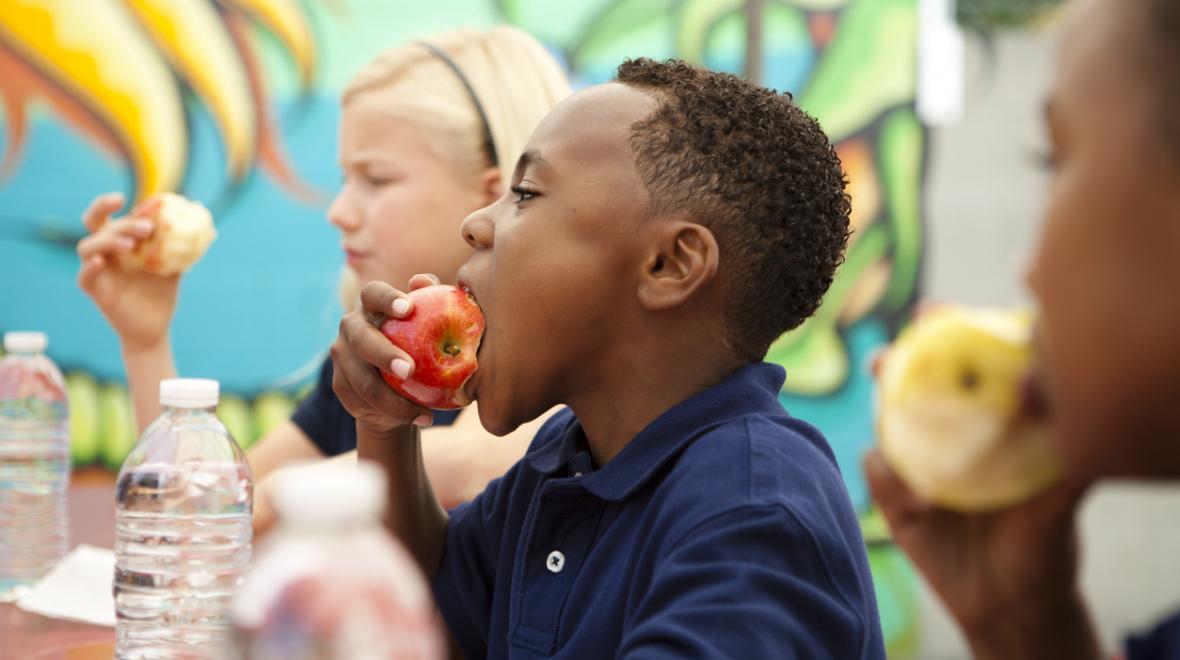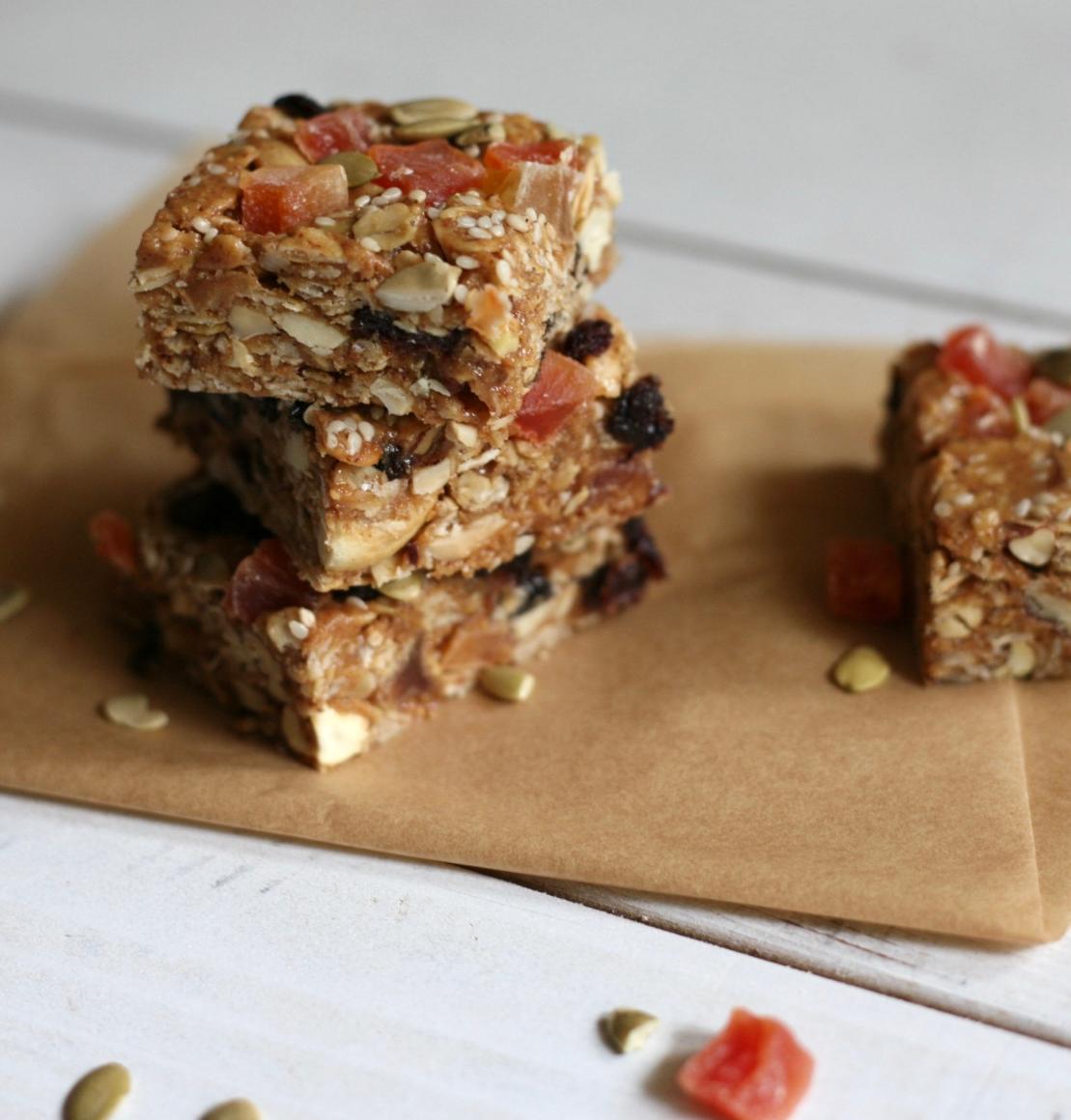
Getting through the school day is tough enough as it is, but if energy stores are running low, “hangry” kids have a hard time focusing on their tasks. Pack their lunch boxes (or snack sacks) with a rainbow of choices to keep kids fueled, focused and ready for what the day brings.
So, what is a superfood, exactly? Most kids probably think it’s a vegetable that can leap over a building in a single bound, or perhaps a fruit with X-ray vision. What the grown-ups know is that superfoods are whole foods packed with vitamins, minerals, antioxidants, fiber, healthy fats and other good-for-you nutrients. These foods will supply kids with much needed body fuel, which in turn gives them energy and a boost in brainpower.
When packing lunches and snacks, try to include as many colors as possible. Kids will enjoy a colorful experience with different flavors, textures and nutritional benefits.
Red: Red fruits and veggies contain lycopene, which has been shown to decrease wheezing and asthma during exercise and protect the skin from sun damage. Salsa that’s loaded with tomatoes, red bell pepper slices with hummus or watermelon cut into cubes (or made into a smoothie) are all kid-approved sources of lycopene.
Orange: Beta-carotene, a powerful antioxidant that helps the immune system, fights cell-damaging free radicals and boosts night vision (it is converted into vitamin A, which creates pigment in your retinas). Beta-carotene is found in brightly colored orange fruits and vegetables. Oranges, mango or cantaloupe will do the trick, but you can also make sweet potato or squash fries, or pack carrot sticks with ranch dressing for dipping.
Salmon, crossing the border of orange to pink, is a great source of heart-healthy omega-3 fatty acids, which are absolutely necessary for healthy brain development. Don’t think your kid will eat a piece of salmon for lunch? Try swapping that canned tuna for salmon in their sandwich, make salmon tacos or try breaded salmon fingers.
Yellow: Like orange foods, yellow fruits and veggies are chock-full of carotenoids. One of the best known is beta-cryptoxanthin (if that’s not a fear-inducing superhero name, I don’t know what is!), which helps decrease inflammation. That means better jumping and harder playing during recess. Bananas, pineapple and corn are all easy ways to get yellow into your kiddo’s diet, but also consider yellow squash baked into muffins or yellow bell pepper slices.
Eggs, with their bright yellow yolks, are rich in B vitamins and also contain vitamin D. In addition to being an easy protein source, they contain a nutrient called choline, which supports brain and memory development. Hard-boiled eggs, egg salad sandwiches or egg-rich mini quiches are just a few ways to get this protein into school lunches.
Green: Most of us know that greens are good for you, but what we may not know is that they’re rich in iron, calcium, fiber, vitamin C and folic acid. Lutein, found in greens, promotes healthy vision (not quite X-ray vision, but close). Kale is the powerhouse of greens, packed with 15 percent of the suggested daily intake of calcium and tons of vitamins A and K. Raw kale might be too strong a flavor for younger palates, so try making kale chips or blending it into smoothies. Don’t forget to try avocado in guacamole or smoothies, asparagus or zucchini made into cheesy “fries,” or peas mixed into pasta salad.
Blue/purple: Berries are a no-brainer when it comes to incorporating superfoods into the lunch lineup, and kids will eat them fresh, frozen or dried. Berries are packed with vitamin C, which is vital for tissue growth and development, and manganese, which helps support bone structure. They are also packed with antioxidants and fiber, but no need to mention that boring fact to the kids.
Brown/tan: This might be a catch-all category, but it’s one of the most important. Most of our healthy fats (in the form of nuts and seeds) and healthy carbs (such as whole grains) land here.
Pulses (think “beans”) are a great source of vegetarian protein and fiber. The high doses of fiber and complex carbohydrates found in beans will keep blood sugar levels stable, reducing the risk of a “crash” from traditional sweet snacks. Most kids love a bean burrito, but you can also roast chickpeas or black beans in the oven and add them to trail mix.
Nuts and seeds are easy to incorporate in a number of ways. Peanuts, almonds and sunflower seeds are great made into spreads for sandwiches, and they cover your kid’s protein, magnesium, B vitamin and healthy fat requirements. Chia seeds contain omega-3 fatty acids, iron and calcium, and can be mixed into homemade energy bars, smoothies and yogurt.
Whole grains, such as brown rice, oatmeal, whole-wheat pasta and quinoa, boost nutrition and reduce the risk of chronic disease in the future. They are also packed with fiber (and some even have protein and iron) that gives you long-lasting energy throughout the day. Mix oatmeal into cookies or make sandwiches with whole-grain bread instead of white.
Clear! Last but not least, don’t forget how important proper hydration is to keep kids going strong all day long. Most kids are dehydrated by the time they are done running around during recess, so make sure they have a water bottle handy throughout the day. You can even pack a rainbow in their water — watermelon, cucumber, orange or melon slices add flavor, color and nutrition.
Recipe: Superfood Energy BarsNo need to turn on the oven for these super kid-friendly superfood bars. Not only can the littles choose the fillings to include, they also can help prepare them on the stovetop with a grown-up supervising. Yield: 18 bars 
Ingredients:
Preparation:Line a 6-cup baking dish with parchment paper. Place the oats in a large saucepan over medium heat. Cook, stirring constantly, until the oats are fragrant, about 5 minutes. Remove from the pan. Combine the oats with the crunchy, chewy and seedy ingredients and the salt in a large bowl. Combine the maple syrup and honey in the same saucepan over medium heat. Bring to a simmer for 2–3 minutes, stirring frequently. Add the almond or sunflower seed butter and oil. Continue to heat and stir until the mixture reaches an even consistency. Stir the nut butter mixture into the oat mixture and combine until evenly mixed (a spatula sprayed with a little oil or gloved hands work best for this). Press the mixture into the baking dish. Allow to cool completely, then flip out onto a cutting board. Cut into 18 bars. Wrap in plastic or store in an airtight container to keep them from drying out. *For the best flavor and to cut out unwanted sodium, choose unsalted toasted crunchy options. Recipe by Jackie Freeman |











